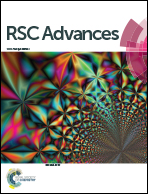A tri-functional TiO2 photoelectrode: single crystalline nanowires directly grown on nanoparticles for dye-sensitized solar cells†
Abstract
We prepared a hybrid photoelectrode with single crystalline TiO2 nanowires (NWs) directly grown on TiO2 nanoparticles (NPs) for efficient dye-sensitized solar cells (DSCs). For this purpose, the NWs were grown on the commercial NPs, P25 Degussa through use of a solvothermal treatment. The NWs offer the dual functions of optical confinement and rapid electron transport, while the incorporated NPs provide a high surface area for dye loading. As a result, the NP–NW hybrid electrode showed 6.6% of the conversion efficiency under AM 1.5 illumination of 100 mW cm−2, which corresponds to a noticeable enhancement over the efficiency of the reference device with the NPs. Thus, we expect that the hybridization of two distinct nanomaterials will provide an effective strategy in designing the photoelectrode of DSCs.


 Please wait while we load your content...
Please wait while we load your content...